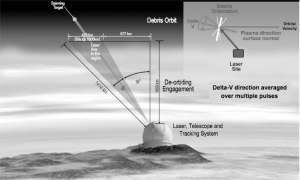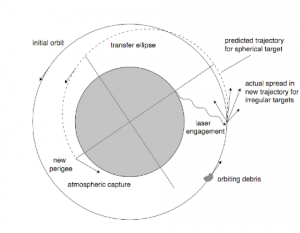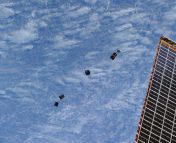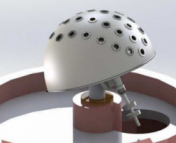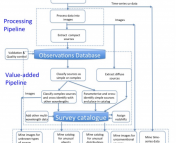• Title: Removing Orbital Debris with Lasers
• Authors: Claude R. Phipps et al.
• First Author’s Institution: Photonic Associates, LLC, Santa Fe, NM
The threat
On an air force base in California, there is a center from which the positions and trajectories of approximately 22,000 pieces of space junk are continually monitored. Every spent rocket booster, or defunct satellite — in fact, every man-made object in Earth’s orbit that’s larger than 10cm in diameter — is carefully tracked. And while that sounds like a lot of debris, that’s only a small fraction of what is out there. When you take into account, in addition, the hundreds of thousands of objects in orbit that we can’t track — space debris smaller than 10cm in diameter, frequently generated by collisions of large debris — you have a veritable minefield of junk.
This debris poses a threat in a number of ways. First, it has the potential to collide with the ISS: just this June astronauts had to take shelter in the Soyuz capsule due to uncertainty in the trajectory of a piece of approaching space junk. The debris can also deorbit in an unpredictable way and, if large enough, survive the atmosphere and reach Earth’s surface — remember the satellite that made headlines last month, or ROSAT’s very recent demise? And at the very least, space junk poses a collisional threat to valuable assets such as functioning satellites currently in orbit.
So what do we do about it?
The authors of this paper revisit an idea that’s been tossed around every so often for the last thirty years: let’s shoot lasers at the space debris.
No, seriously.
Specifically, the authors advocate using pulsed laser orbital debris removal (LODR). This system requires a ground-based telescope and tracking system with an associated pulsed laser. Once a debris target is attained, repetitive pulses from the laser are focused on it, generating a plasma jet from the surface of the object. This process is designed in such a way that the orientation of the jet is opposite the object’s orbital direction, slowing the debris down by just enough to result in rapid reentry (see the inset in Figure 1, and Figure 2). The debris then burns up in the Earth’s atmosphere.
Why this will work
In the past, this idea has been declared impractical, due to the large amounts of energy which need to be deposited on large objects in order to change their trajectories. So what’s changed recently to make this idea not only feasible but, according to the authors, the lowest-cost option for clearing out space debris?
The authors list several developments which have improved the practicality of LODR. First, large and lightweight mirrors are now much easier (and cheaper) to make, so focusing the laser is less of an issue than it once was. The advances in adaptive optics are also important in their impact on our ability to track and aim at small debris. Furthermore, laser systems have become significantly more advanced over the past decade, and now can achieve the range of energies and powers required to remove orbital debris. In the case of a 1-ton object, considered a large target, the authors estimate that 140-kJ pulses with an average optical power of 370 kW would be needed (for comparison, a laser pointer has a power output of 1-5 mW; more examples can be found here).
Final thoughts
The authors claim that, at a few thousand dollars per small object and roughly $1M for each large object, this is the most cost-effective option that is currently on the table for debris-clearing. They also point out that a LODR system could have many additional uses, such as orbit modification on demand for large objects (if, for instance, you want to avoid an impending collision between a piece of debris and a working satellite), or controlling the re-entry point of a large object more precisely (so as to avoid another fuss like last month’s). As a final rather interesting point, they mention that international cooperation would be imperative in the development and construction of this project, so as to avoid concerns that it is a weapon system.
Note: Thanks to Sukrit for finding this paper!

